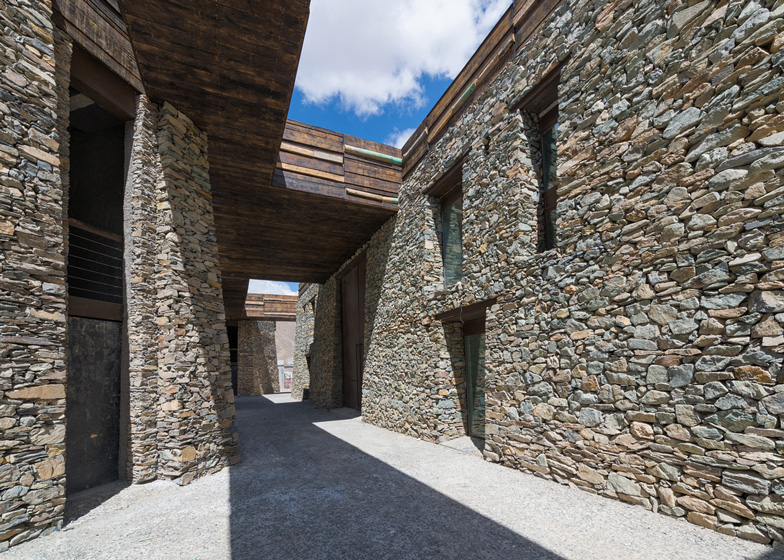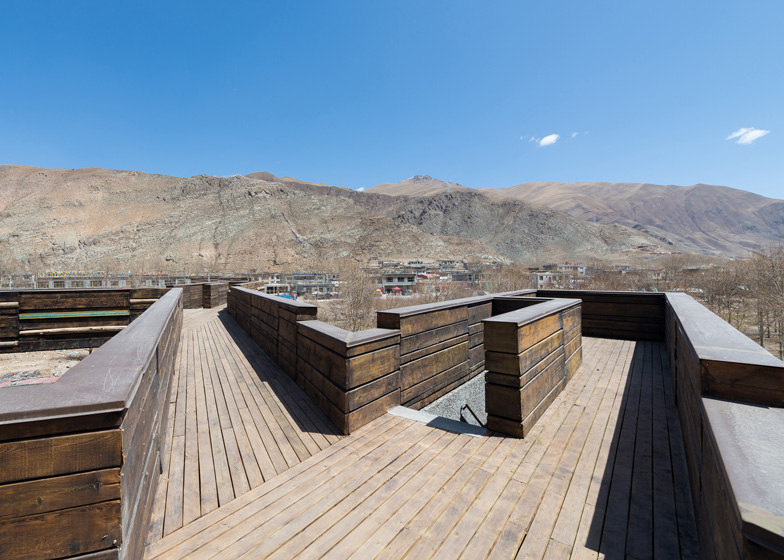Beijing studio Atelier TeamMinus has completed a visitor centre for an ancient Buddhist memorial in Tibet, which features stone walls, a central courtyard and 11 rooftop observation decks (+ slideshow).
Located in the Chinese province of Yushu, the Jianamani Visitor Centre accompanies the Jianamani cairn - a historic mound of inscribed stones amassed by pilgrims over the last three centuries.
Atelier TeamMinus was commissioned to design the building in 2010, shortly after an earthquake hit the region. As well as providing an information source for tourists, it functions as a community centre for the local residents who worked hard to repair the damage caused by the natural disaster.
The architects used traditional Tibetan architecture as a guide when generating the plan of the building. They created a square building with a central courtyard, then surrounded it with observation towers that offer views of various historical landmarks nearby.
Stone was used for the walls, resonating with the inscribed stones that make up the Jianamani memorial.
"The stone masonry is done by local masons, using the same kind of local rock from which Mani stones are carved," explained the architects.
The rooftop decks were constructed from timber, some of which was sourced from earthquake debris.
Inside, the building is laid out over two floors and accommodates a post office, a clinic, public toilets and a small research archive.
The project was presented at the World Architecture Festival in Singapore earlier this month. It was shortlisted for an award in the display category but lost out to a whirlpool-shaped museum in Copenhagen.
Read on for a project description from Atelier TeamMinus:
Jianamani Visitor Centre
Yushu is a highly regarded religious centre to Tibetans. Its significance comes mainly from Jianamani, the world's largest Tibetan Buddhist cairn. With a history of over 3 centuries, Jianamani currently bears over 250 million pieces of Mani stones, and is still growing with new pieces added daily by pilgrims.
In Yushu, more than 40% of the populations live on the carving of Mani stones. To the Yushu community, nothing compares to Jianamani. After the 2010 earthquake, Yushu-ers immediately set off to repair Jianamani, long before they started repairing their own houses.
The Jianamani Visitor Centre serves both visitors and the local community. To visitors and pilgrims, it provides information about Jianamani and its history complemented by viewing the surrounding historical sites. To local Yushu-ers, it provides a post office, a clinic, public toilets and a small research archive.
The Jianamani Visitor Centre consists of a square building with a courtyard in the centre, and 11 observation decks surrounding it. The central square volume features the typical Tibetan layout. Of the 11 observation decks, 2 point to Jianamani, 9 point to historic/religious sites related to Jianamani, including: Leciga, Genixibawangxiou, Cuochike, Dongna Zhunatalang Taiqinleng, Zhaqu River Valley, Lazanglongba, Rusongongbu, Naigu River Beach, and Kuanyin Rebirth Site.
The Jianamani Visitor Centre is mainly built with the local construction techniques. The stone masonry is done by local masons, using the same kind of local rock from which Mani stones are carved. The railings around the roof terrace and the observation decks are made of wood, with some parts recycled from earthquake debris.










